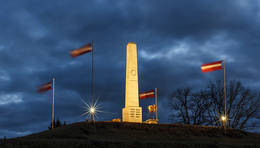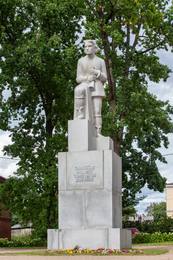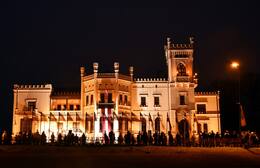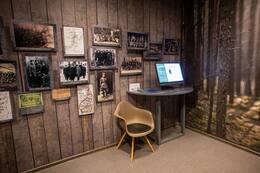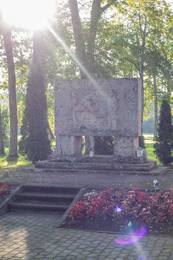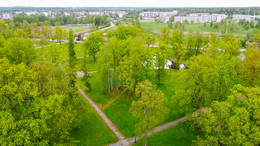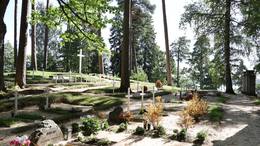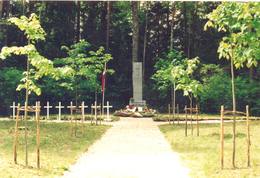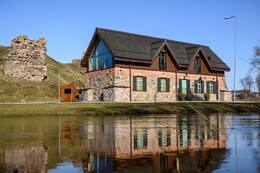7. Sigulda Infantry Regiment I Wars of Independence
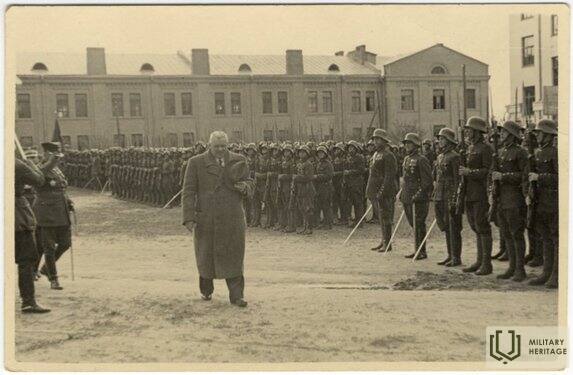
On the eve of the decisive battle of Cēsis, on June 20, 1919, by order of Colonel Jorgs Zemitans, the 3rd Infantry Regiment of Jelgava was formed by uniting the reserve battalions of the Northern Latvia Brigade in Rūjiena and Naukšēni, which was renamed the 7th Sigulda Infantry Regiment on August 23. The first commander of this unit was Lieutenant Colonel Oscar Danker. The regiment was assigned to the Latgale division.
After its formation, the regiment was transported by rail to Tallinn (Rēveli), where on June 29 it received 500 rifles and was transported to Liepāja by the British naval cruiser "Dragon" and 2 minesweepers, where it was located in the barracks of the War Port. 6. rotu 25.07. was sent to Ventspils, the 2nd company remained in the garrison service in Liepaja.
7. Sigulda Infantry Regiment took part in the battles against the Bermont troops and the liberation of Northern Latgale. The regiment's soldiers took part in many battles, including at Katleši, Vecumu and Purvmala stations, as well as the liberation of Jaunlatgale and Augšpils. In the war of independence, 116 soldiers of the regiment fell or died and 79 disappeared without a trace. 85 soldiers of the regiment were awarded the Lāčplēsis War Order.
After concluding the Latvian-Russian peace agreement, the regiment was still on the eastern border (in Rēzekne), where it was guarding the border from Rītupe station to the Estonian border until the arrival of the border guard units. In January 1921, the regiment was moved to the vicinity of Alūksne and Gulbene. On April 1 of the same year, the regiment was reorganized in peacetime state. In 1923, the first two-storey barracks were built in Alūksne, but in 1929, the second three-storey barracks building was built. In 1935, the 11th Dobele Infantry Regiment Battalion was stationed in Gulbene, which was included in the regiment as the fourth battalion, thus the 7th Sigulda Infantry Regiment became the largest regiment in the Latvian Army.
After the Soviet occupation in 1940, the 7th Sigulda Infantry Regiment was liquidated on September 10. The soldiers were enlisted in the 285th Rifle Regiment of the 24th Territorial Rifle Corps of the USSR Red Army.
More information sources
In memory of the Sigulda regiment. 1919. 20- VI 1959. Sigulda Regiment Memorial Fund, Lincoln, 1959-231.
Oscar Dankers. How I became the founder of the 7th Sigulda Regiment and the first commander of the regiment. Collection of articles: Ziemeļnieki II, 1974.- http://www.periodika.lv/periodika2-viewer/view/index-dev.html#panel:pp|issue:/g_001_0306121295|article:DIVL839|issueType:undefined
7th Sigulda Infantry Regiment - 100th SARGS.LV 19.06.2019. https://www.sargs.lv/lv/vienibas-un-personibas/2019-06-19/7-siguldas-kajnieku-pulkam-100
Related timeline
Related objects
Monument to the soldiers of the 7th Sigulda Infantry Regiment who died in the Latvian War of Independence
Located on the shores of Lake Alūksne, on the edge of Pleskavas Street (Kolberg Road).
On June 22, 1923, the President of Latvia, Jānis Čakste, unveiled a monument to the fallen soldiers of the 7th Sigulda Infantry Regiment. The monument is based on the design of the artist Jūlijs Miesnieks.
The soldiers of the regiment also improved and maintained the area around the monument. Soldiers gathered at the monument on the eve of the regiment's annual holiday, when the holy fire was lit, as well as on the day of the regiment's year after the parade and intercession in the garrison cemetery.
1940/1941 The Bolsheviks removed and destroyed the plaque in 1953, but the monument itself was demolished in 1953 and its stones were laid in the foundations of the corner of the barracks house.
At the beginning of the Awakening, in the autumn of 1989, the vicinity of the destroyed monument, which was still in the territory of the USSR occupation forces, was cleaned up. On November 11, a temporary granite memorial was unveiled at the former location of the monument, with the text: "The monument of the 7th Sigulda Infantry Regiment will be restored in this place on November 11, 1989."
Thanks to the initiative of U. Veldre, the head of the Alūksne Brothers Cemetery Committee, the restoration of the monument was started and on October 16, 2009 the restored monument was unveiled.
Unlike the original monument, a cross was created on the obelisk regiment instead of a chest sign. Both sculptures of the monument were wrought by the sculptor Ainars Zelcs. Both the part of the 22 original obelisk blocks found on the territory of the National Armed Forces Infantry School and the newly built blocks were used for the restored monument.
On June 20, 2019, as part of the centenary of the Sigulda Infantry Regiment, a memorial site and a granite memorial plaque to the fallen soldiers of the unit were unveiled at the foot of the monument hill. The memorial site was built with funds donated by the staff of the Infantry School of the National Armed Forces.
Monument “Tālavas taurētājs”
Located in Rūjiena Center Square.
The three-meter-high image of an ancient Latvian guardian carved in gray Finnish granite, called the “Tālava trumpeter”, is placed on a three-meter-high granite pedestal, but the total height of the monument reaches 7.5 meters. In the initial sketches and models, K. Zemdega had placed a sword in his hands, which was later replaced by a trumpet. The monument was unveiled on August 15, 1937.
This monument reflects the difficult situation in the formation of our country and army, as well as in the assessment of these events. Immediately after the proclamation of the Latvian state, the Red Army invaded and the interim government of Kārlis Ulmanis established a refuge in Liepāja. In February 1919, with the help of the Estonian army, the liberation of Latvia from the north began and the first mobilization took place in the Rūjiena area for the Latvian troops formed in Tartu, which became the Northern Latvian Brigade under the command of Colonel Jorgis Zemitans. The Northern Latvian brigade fought not only against the Bolsheviks, but also against the Landeswehr and Iron Division in the battles of Cēsis. The soldiers of Northern Latvia, mobilized in the vicinity of Rūjiena, also fought in the subsequent battles for the War of Independence. After the war, the main laurels were won by General Jānis Balodis and the Southern Latvian Brigade he commanded, but he often forgot about the Northern Latvian Brigade. The monument to Rūjiena, which was planned in Rūjiena, was built for a long time, and the monument, unveiled in 1937, was officially popularized as a monument to the liberation of Rūjiena and the memory of fallen soldiers, not to mention the beginning of all regiments in Northern Latvia.
The monument is not only a popular sight for Latvian and Estonian tourists, which is to some extent a starting point for visiting several other places of remembrance of the War of Independence in Rūjiena, but "Tālavas taurētājs" is also a stopping place for Estonian and Latvian officials of various levels.
The monument to the liberation and fallen soldiers of Rūjiena, more commonly known as the “trumpet of Tālava”, was included in the list of cultural monuments protected by the state as an art monument of national significance on October 29, 1998 (monument protection registration number 4522).
Alūksne Museum
The Alūksne Museum is located in an architectural monument of national significance: the neo-Gothic Alūksne New Castle built in the late 19th century. The museum features an exhibition named ‘Memorial Room for Victims of the Totalitarian Regime’, which tells about the fate of the inhabitants of Alūksne municipality in Siberia and the Far East, while the time periods from prehistory to the present meet in the Alūksne history exhibit ‘Feast of the Ages’. It features a separate section devoted to the contribution of the 7th Sigulda Infantry Regiment to the military, culture and public life. The formation of the 7th Sigulda Infantry Regiment began on 20 June 1919 in the Naukšēni Manor. Initially, a battle group of 22 officers and 1,580 soldiers was formed from the reserve battalion of the Northern Latvian Brigade, and was named the Dankers Division. It was included in the 2nd Battalion of the 3rd Jelgava Regiment. On 23 August, following an increase in the number of companies, it became part of the 7th Sigulda Infantry Regiment. Having taken part in the battles against Bermondt, on 5 January 1920, the regiment was transferred to the Latgale front to fight the Bolsheviks. After the signing of the Peace Treaty with Soviet Russia, the regiment guarded Latvia’s eastern border. The Latvian War of Independence saw the deaths of more than 200 soldiers of the regiment, while 85 were awarded the Lāčplēsis War Order. In 1921, the 7th Sigulda Infantry Regiment was stationed in Alūksne. The regiment’s headquarters were set up in the Alūksne New Castle. After World War II, the castle was taken over by Soviet security institutions. As of the late 1950s, the castle housed various cultural institutions: the Culture and Cinematography Department of the Executive Committee, a pioneer house, a library, a cinema and a museum.
Exhibition "Ziemeļlatgale in the freedom struggle" in Balvu County Museum
The exhibition allows you to look into the history of Latvian Independence from the point of view of Northern Latgale. What is the contribution of the people of our side, how did our grandfathers get involved in the fight for the common cause of Latvia, what are their fates, how is their memory preserved? Answers to these and other questions can be found in Latvian, Russian and English.
The Northern Latgale liberation operation, also called the Viļakas-Jaunlatgale capture operation, was part of the Latgale liberation attack operation carried out by the Latvian armed forces during the Latvian freedom struggle. Its purpose was to occupy the northern part of Latgale and cut the Pskov-Daugavpils railway line in order to prevent the arrival of additional units of Soviet Russian troops from the Estonian front and from inside Russia. The most important battles took place between January 9 and 20, 1920, when control over the railway line from Pitalova (Abrene) to Kārsava was gained.
Monument to the liberators of Northern Latvia
Located in the center of Placa by the Inčukalns - Valka highway (A3). Next to the bus stop and Straupe People's House.
The monument made by Teodors Zaļkalns to the liberators of Northern Latvia in 1919 at the Battle of Cēsis can be seen.
There are two limestone supports on the three-step base, on which the limestone block rests. In front of it, the lower part depicts a horse harnessed to a plow and a plow holding reins in his right hand and a sword in his left. A text engraved on the back of the monument, closed by lines by the poet Eduards Virza:
FOR THE RELEASES OF NORTHERN LATVIA
WHILE THE CEREALS ARE SEED IN THESE FIELDS
YOU WILL BE GLORIFIED AND HONORED
The monument was unveiled on November 8, 1931. President Alberts Kviesis took part in the opening.
Latvian military aviation aerodrome
Located in the territory of Vecgulbene manor - in the historical center.
In the interwar period, the garrison of the Latvian Army was located in Gulbene, where the 7th Sigulda Infantry Regiment Battalion was stationed. Aerodromes are especially important in places where important railway and road junctions have been established. In 1937, a newly established unit of the Aviation Regiment was stationed in Gulbene, which became the 6th Division of the Latgale Division Scouts, increasing the number of army units near the eastern border of Latvia.
The conservatory building is visible.
Alūksne Garrison Cemetery
Located on the shores of Lake Alūksne, on the Kapsēta peninsula, in the territory of the Great Cemetery.
They were started and maintained by the soldiers of the 7th Sigulda Infantry Regiment in the 1930s and consecrated on November 11, 1932. After the restoration of Latvia's independence, Uldis Veldre, the head of the department of the Alūksne Brothers' Cemetery Committee, took care of the maintenance of the Garrison Cemetery, the identification of the resting places associated with Alūksne and the installation of memorials in the Garrison Cemetery.
Military personnel of the Army of the Republic of Latvia were buried in the garrison cemetery, as well as soldiers and civilians killed in the fight against the Bolsheviks on July 4, 1941 in Alūksne near Jāņkalniņš and on July 7, 1941 in Ziemera parish.
Most of the buried have white wooden crosses with metal plaques, which indicate the name of the deceased, the rank or occupation, as well as the date of birth and death.
On December 19, 1990, a memorial to Vilius Spandeg, a knight of the Lāčplēsis Military Order, was unveiled in the Garrison Cemetery. Standard memorial plaques were also erected to the LKOK, who died or were killed in communist concentration camps and were not buried in Latvia. On November 11, 1990, a memorial was erected to Voldemārs Zaķis, who died in the communist concentration camp.
Karvas Brothers Cemetery
It is located on the side of Alūksne - Ape road near the Eel House, south of Karva, turning to Rezaka.
The monument was unveiled on September 12, 1937. The granite stencil was designed by Oem Dambekalns in Riga in Riga by the architect Vemera Vitand.
In the autumn of 1975, the local communists destroyed the monument. On March 30, 1989, the Alūksne District Council decided to restore the monument, and on April 30, 1989, a temporary wooden memorial in the form of a Latvian tombstone was erected by Jānis Jaunzems, a worker at the State Electrotechnical Factory (VEF). It read: "The monument to the Karvas Brethren will be restored here."
At that time, the adjacent Brothers' Cemetery was also improved.
In 1993, thanks to the initiative of Uldis Veldre, the head of the Alūksne Brothers' Cemetery Committee, the restoration of the memorial site resumed. The new monument was made by Cēsis stonemason brothers Aivars, Austris and Auseklis Kerliņi.
The monument was unveiled on June 11, 1994.
Four soldiers of the 5th Company of the Valmiera Infantry Regiment are buried in the Brothers' Cemetery - Jēkabs Sukse, Pēteris Leitlands, Ernests Puķītis and Gustavs Ozols, who died on April 2, 1919 in the battles at the Eel House. Roberts Grazer, a soldier of the Valmiera Regiment, was buried as the fifth soldier of the Valmiera Regiment in the mid-1930s, and disappeared on March 31, 1919 at the New Manor. Initially, he was buried as an unknown, but later the name was found and carved into the monument. Augusts Dzedons (Ziedons), the fifth soldier who died in the Battle of Eel, was buried in the Apekalns cemetery.
A memorial plaque has been erected at the foot of the monument to Jānis Goldem (1891–1952), a participant in the eel battle in LKOK, who died in the Communist concentration camp in Inta, Komi.
The second memorial plaque, unveiled on August 23, 1992, was erected at one of the wooden crosses and is dedicated to Corporal Peter Janson of the 7th Sigulda Infantry Regiment, who was assassinated by the oncoming communists on July 7, 1941.
Treasure House of the Free State
The Treasure House of the Free State is located next to the Rēzekne Castle ruins.
The unique exhibition includes hundreds of different histori cal testimonies from Latvian and foreign private collec tions, covering the period from 1918 to 1940, revealing the events in the history of Latgale and Rēzekne. It presents the history of military and civilian awards of the First Free State of Latvia, as well as various organisations related to the activities of state and civic organisations in the period from the Latvian War of Independence to World War II. The collection of military and civilian awards and insignia of the Latvian Free State on display here is the largest one in Latvia. The Changing Exhibition Hall is situated on the second floor, where a new exhibition is held at least once per year.
To date, visitors have had the opportunity to see a unique collection of porcelain objects, luxury clocks from France and paintings depicting various landscapes of Latgale.
Related stories
7. Formation of Sigulda Infantry Regiment
On June 20, 1919, in the Naukšēni manor, near Rūjiena, the formation of the 7th Sigulda Infantry Regiment was started, according to the order of the Commander of the Northern Latvia Brigade, Colonel Jorgs Zemitans. Initially, a small battle group of 22 officers and 1,580 soldiers was formed from the Northern Latvian Brigade Reserve Battalion, which was named the Danker Division in honor of its first commander, Oskars Dankers. A few days later, the unit was included in the 2nd Battalion of the 3rd Jelgava Regiment, but on August 23, adding to the number of jewelry - in the 7th Sigulda Infantry Regiment.
Awarding of the 7th Sigulda Infantry Regiment in bermontiad, awarding of the great soldier Valija Veščūnas with the Lāčplēsis War Order in Alūksne
After the Latvian War of Independence, the great soldier Valija Veščunas was awarded the Lāčplēsis War Order for the November 19, 1919 battles with the Bermontians at the Plan House. Valija Veshchun was one of the first to cross the Lielupe under the fire of the enemy.
Memorial moment in the Garrison Cemetery
After the restoration of Latvia's independence, Uldis Veldre, the head of the department of the Alūksne Brothers' Cemetery Committee, took care of the maintenance of the Garrison Cemetery, the identification of the LKOK-related resting places related to Alūksne and the installation of memorials in the Garrison Cemetery.





